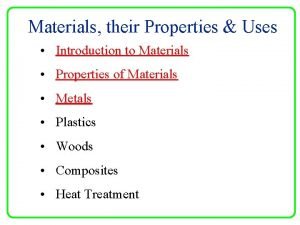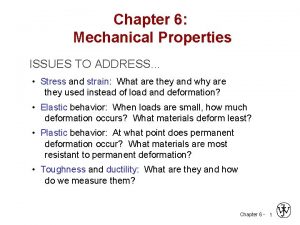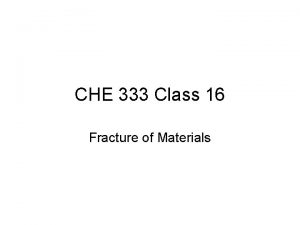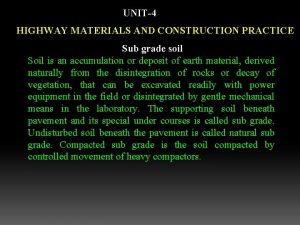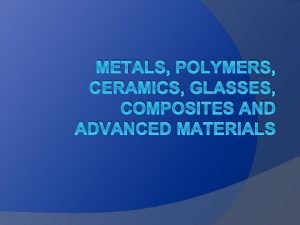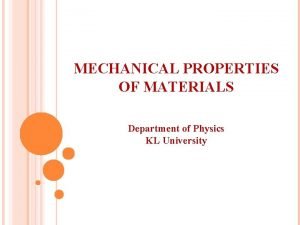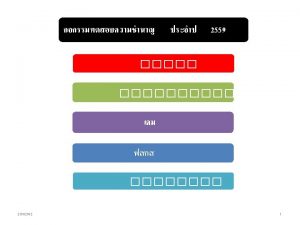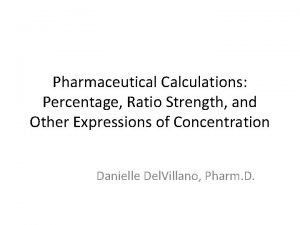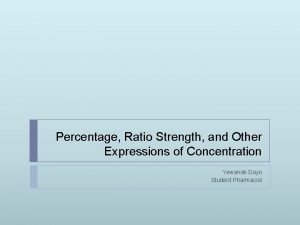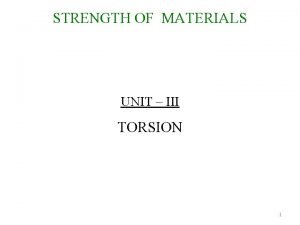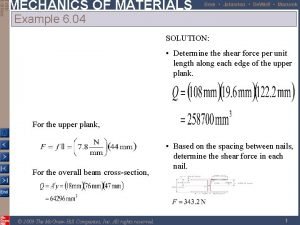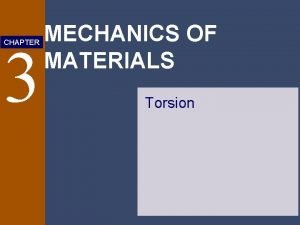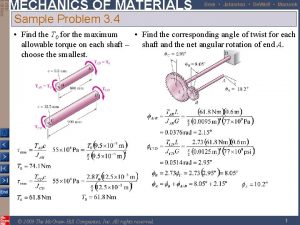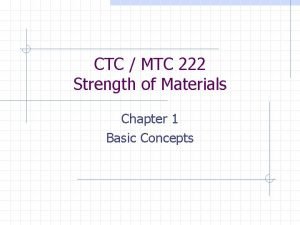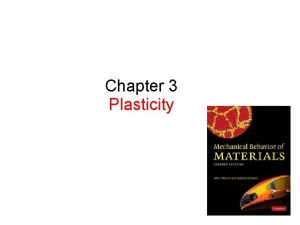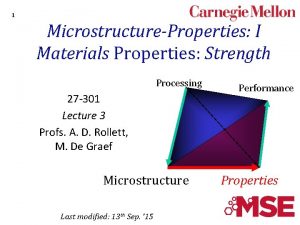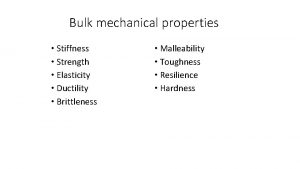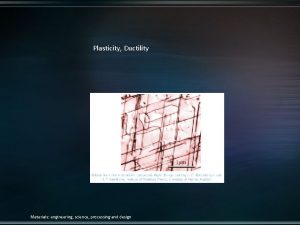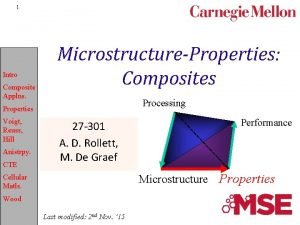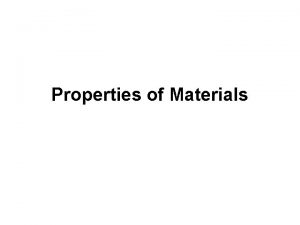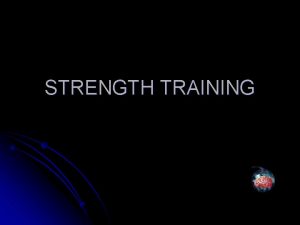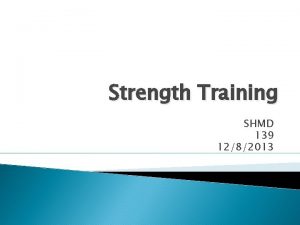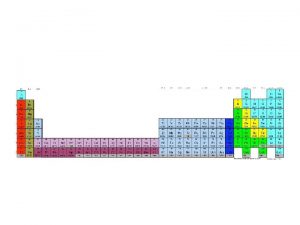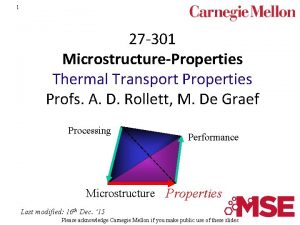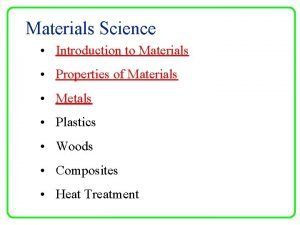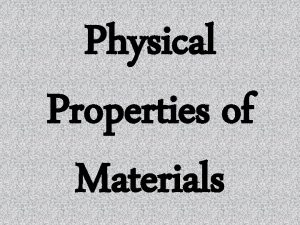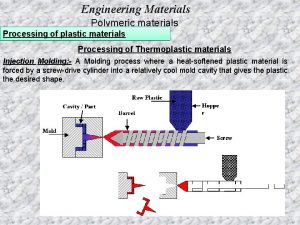1 MicrostructureProperties I Materials Properties Strength Ductility Processing










![11 Strain - diagram [Courtney] 11 Strain - diagram [Courtney]](https://slidetodoc.com/presentation_image_h/b694d831a7a9683c00b330e77c256428/image-11.jpg)





















- Slides: 32

1 Microstructure-Properties: I Materials Properties: Strength, Ductility Processing Performance 27 -301 Profs. A. D. Rollett, M. De Graef Microstructure Last revised 27 th Sept. 2015 Properties

Objective 2 • The objective of this lecture is to explain the characteristics of the tensile test, which provides information on both the strength and the ductility of materials. • Strength and ductility are defined and used to illustrate the relationship between materials properties and microstructure. • The measurement of a “stress-strain” curve is described. • More specifically, this lecture explains the “Considère Criterion” that relates the onset of necking (in a tensile test) to work hardening rate of a material: ds. T/d = s. T • The “Considère Criterion” is a reasonably reliable way to quantify ductility where this is defined as the uniform elongation, i. e. the amount of strain that can be obtained in a tensile test with uniform reduction in cross-section. The total strain to failure measured as reduction in area may be significantly larger than the uniform elongation, especially if the material exhibits positive strain rate sensitivity. • Look at www. steeluniversity. org, or http: //www. steeluniversity. org/content/html/eng/default. asp? catid=1&pag eid=1016899460, and specifically “Tensile Test”, “Hardness Test”, for self-learning guides

3 1. 2. 3. 4. 5. 6. 7. Q&A How is strain related to displacement? Strain is the gradient in displacement. How is strain related to change in length in a tensile test? Strain=∆l/l 0. How is uniform elongation defined? Uniform elongation is the strain up to the point of necking (in a tensile test). How is reduction in area defined? This is the strain computed from the ratio of final to initial cross-sectional area. Why is reduction in area generally larger than the uniform elongation? Because the former includes the post-necking strain. What is the proof stress? This is the stress measured after 0. 2% strain (sometimes 0. 1%). What is the compliance correction? This corrects the stress-strain curve for the finite compliance of most testing machines; see notes for details. 8. 9. 10. 11. 12. How do we measure Ultimate Tensile Strength (UTS)? This is the peak in the stress curve (engineering quantities). What is true stress? Force divided by current area (cf engineering stress which uses the original/initial area). How is logarithmic (or true) strain defined? How is it related to the engineering strain? Logarithmic strain is the natural log of 1+en. How do we derive the relationship that tells us that the uniform elongation is the point at which the true stress equals the hardening rate? We solve for the condition that the material cannot support an increase in load. What is the Considère construction? This is a graphical equivalent to the above derivation; one plots true stress versus engineering strain and draws the tangent to the curve that passes through (-1, 0).

Notation 4 L, l, l 0 : = f : = G (or µ) : = s, s. T, sn : = t, t. CRSS : = u : = A, A 0 : = E : = F : = m : = M : = l, f : = specimen length, initial length strain to failure shear modulus stress (macroscopic), true stress, nominal/engineering stress (respectively) shear stress (critical value, in some cases) displacement area (cross section of specimen), initial area Young’s modulus force Schmid factor Taylor factor, test frame compliance angles between tensile axis and slip direction, slip plane normal, respectively

Key Concepts 5 • • • Stress, yield strength, typical values, extreme values Strain, engineering versus logarithmic strain Stress-strain curves Compliance correction for stress-strain curves Ductility, necking limit, relationship to hardening parameters, Considère’s Criterion

6 Strength • Strength, or flow stress, is very basic to the value of a structural material. We measure it in terms of force per unit (cross-sectional) area: s = F/A • Strength means resistance to irreversible deformation or, if you prefer, the upper limit of elastic stress that is safe to apply to a material. • Strength is highly dependent on microstructure because it is proportional to the difficulty of moving dislocations through (and between) the grains. • Typical values? Most useful structural metals have strengths in the range 1001000 MPa; ultra-high strength steel wire can be produced with strengths greater than 5, 000 MPa! • Engineers are often taught strength as being related to (chemical) composition. Materials engineers study strengthening mechanisms and therefore understand how to control strength. • Strength is typically measured in a tension test, but we will also examine this test when we discuss ductility. • Mechanical engineers often are required to take a course in “Strength of Materials”, which discusses the mechanical properties of materials (often without reference to the microstructures, which explain the physical basis for the properties).

Types of Strength 7 • Elsewhere in the course, we discuss stress and strength as tensor quantities. Here, we will treat them as scalar quantities, i. e. a single number. – A technical detail is that tensor stress and strain can be reduced to a single number by computing the von Mises equivalent stress or strain. • There are different modes of loading materials: – – – Yield Strength: ambient conditions, low strain rate Dynamic Strength: ambient conditions, high strain rate Creep Strength: high temperature strength, low strain rate Torsion Strength: strength in twisting Fatigue Strength: alternating stresses • The strength value is highly dependent on the loading mode. • Each type of strength is controlled by a variety of strengthening mechanisms.

8 Yield strength • A yield strength is boundary between elastic and plastic flow. Example: tensile stress elastic s=0 plastic s= syield s

9 Ductility • Ductility measures the ability of a material to undergo plastic deformation without fracture intervening. • Ductility is the hallmark of structural materials because it makes structures damage tolerant. If one element of a structure is overloaded, it will deform before it breaks and thus not jeopardize the entire structure. • We cannot discuss ductility without first defining strain and then examining stress-strain behavior. • Ranges of ductility: most oxides break (in tension) before they yield plastically. Useful structural metals have at least 5% ductility. Superplastic materials and polymers (not just metals!) can exhibit enormous ductilities, >500%! High strain rate superplasticity of an Fe-Cr. Ni-Mo dual-phase stainless steel. Grain refinement of (+) duplex structure up about 1µm has established a large elongation over 1000% even at high-strain rates in the order of 0. 1 s-1. http: //hightc. mtl. kyotou. ac. jp/english/laboratory/micro structure/microstructure. htm

Strain 10 • Strain measures the change in shape of a body. If you apply a force to a body, naturally there is a change in size. By normalizing the change in a given dimension by the original dimension, one arrives at a quantity that again can be used to characterize the properties of a material. • strain = [change in length]/[original length] = ∆L/L 0 = (L-L 0)/L 0. • Reminder: strain is, in general, a tensor because a body can change shape in all three directions at once.
![11 Strain diagram Courtney 11 Strain - diagram [Courtney]](https://slidetodoc.com/presentation_image_h/b694d831a7a9683c00b330e77c256428/image-11.jpg)
11 Strain - diagram [Courtney]

12 Strain - notes • A better definition of strain is that of a gradient in displacement of points in a body. Take a tensile strain as an example: if we fix one end of the body and apply a tensile force, then the fixed point does not move. The point at the other end of the body moves the most. The change in position, i. e. the displacement, is then proportional to the distance away from the fixed point. The strain can then be defined as the gradient in displacement, u; = du/dx, where x is the position along the body. • In order to measure strain, one must choose points on a specimen, measure their spacing, perform the test, and then re-measure. • Since strain is always a ratio of lengths then it is dimensionless. Per-cent (%) is useful because many materials have ductilities less than 50%. Fractional strain is also used, however.

13 Stress-Strain: measurement • The measurement of the stress-strain characteristics of a material, which we will perform in the second laboratory in 301, requires us to examine some practical aspects. • At ambient conditions and easily attained strain rates (room temperature, one atmosphere of air, strain rates between 10 -5 and 100 per second), the most straightforward test is the tensile test. A bar of constant cross section [area] is stretched at controlled displacement rate. The load required for the stretch is recorded. • Essentially all materials exhibit a maximum strain, beyond which failure (fracture) occurs. • Note that, although strength is a tensor quantity, one can only measure in one direction at once. In many cases, it is reasonable to assume isotropy.

Stress-strain curves 14 • If one applies a large enough load to a ductile material (of uniform cross-section) plastic deformation will result in the following (typical) behavior. • • The elastic strain can be subtracted from the total strain in order to produce a curve of stress versus plastic strain only, which is useful for many problems. A linear stress(elastic) strain response is assumed; for each data point, the elastic strain corresponding to that stress (stress÷modulus) is subtracted (translate to the left, parallel to the strain axis). This procedure can also be used to correct for machine compliance. Plastic Elastic Courtney

15 Observations • Note (right) how the strain (color) is uniform at first but becomes increasingly concentrated in the neck. Images of an actual test are shown below. http: //www. ara. com/Projects/SVO/popups/weld_geometry. html

Compliance Correction 16 • Often, a tensile testing machine is not perfectly stiff and the lack of stiffness is evident in the test results as an apparent elastic modulus that is lower than the expected value (i. e. what you find in a handbook). The reason is that applying a load to the specimen produces elastic displacements in the machine as well as in the specimen. Displacement is measured at the cross-head and so additional, apparent strain occurs. This can be corrected for in a straightforward manner by measuring the difference in slope between the measured, Emeasuredl, and the known elastic modulus, Ematerial. This permits a machine displacement to be computed at any given load, and the resulting strain is subtracted from the measured strain value.

17 Stress-strain characteristics • The initial part of the curve represents the elastic regime of the material. If the load is released, the strain of the specimen will return to zero and no permanent deformation occurs. The slope of this part of the curve is called Young's modulus or Modulus of Elasticity. • Further imposed strain results in a drastic change in slope of the curve which signals the onset of permanent plastic deformation. The yield strength is a measure of the stress required for permanent plastic flow. The usual definition of this property is the offset yield strength determined by the stress corresponding to the intersection of the curve and a line parallel to the elastic part but offset by a specific strain (usually 0. 2%). Beyond this point, the material work hardens until the ultimate tensile strength is attained. At this point, the incremental increases in stress due to decrease in cross-sectional area becomes greater than the increase in load carrying ability due to strain hardening. Starting at this point, all further strain is concentrated in the "necked" portion of the specimen.

18 Ductility measures • The reduction of area at fracture and the elongation to fracture are used as percent reduction of the original area and percentage increase of the original gage length. The percentage reduction of area at fracture is only slightly affected by the shape of the tensile test specimen. As long as the ratio of the width to thickness does not exceed about 5: 1, for a rectangular cross-section, the percent reduction of area remains the same as for circular cross-sections. • Elongation to failure = ef = (Lfinal-L 0)/L 0 x 100% • Reduction in Area = ( A 0 – Afinal ) / A 0 x 100% • The reduction of area is usually larger than the elongation to fracture. This is the result of post-necking strain (to be discussed in more detail).

19 Derived Quantities • The Gauge Length is the length between the shoulders of the specimen • Elongation to fracture is usually measured by fitting the broken specimen back together and measuring the distance between punch or scribe marks. Elongation may also be calculated from the load-extension diagram; the two do not necessarily agree. Elongation is so much affected by the gauge length over which it is measured that the gauge length must always be specified when reporting data. • Tensile Strength, or, Ultimate Tensile Strength (UTS) is the maximum stress that the material experiences during the test. • Work Hardening or Strain Hardening is the increase in stress during the test.

20 Engineering Stress, Strain • One important technical issue in tensile (and compression) tests arises from the change in area. • Load-displacement curves are all that can be measured in a tensile test. Load must be divided by area to arrive at stress. Displacement must be divided by an initial length (such as a gauge length) to arrive at a strain. • If the initial cross-sectional area, A 0, is used to calculate stress, then this is known as nominal or engineering stress. sn = F/A 0 • Engineering stress -strain plots are useful because they show the maximum load carrying capacity of the material by the change in sign of the slope (peak in the curve at dsn/de=0). • Similarly, use of linear strain based on the initial length is known as nominal or engineering strain. en = ∆L / L 0

21 True Stress, Logarithmic Strain • If the stress is divided by the current area, A, then the current, or true stress is obtained. The current area is easily obtained from the length. • Constancy of volume: it is an experimental fact that the volume change experienced in ductile flow is negligible. This is a result of plastic flow being accommodated by shear/slip. Therefore, AL = A 0 L 0 • This permits us to write, s = F / A = FL / A 0 L 0 = F(L 0+∆L) / A 0 L 0 = F(1+ n) / A 0 = sn(1+ n) • True, or logarithmic strain, T, is defined as,

22 Why is Ductility important? • Why do materials exhibit ductility? The reason for ductility in metals is that they work harden. – The key concept is the re-distribution of strain. That is to say, if one sub-region of a material hardens as a result of the accumulation of dislocations then its load carrying capacity is higher than that of the neighboring regions. More specifically, the flow stress is lower in the non-hardened regions than in the hardened region. Therefore plastic flow (i. e. the strain rate) is larger in the non-hardened region(s) and, in effect, the strain is redistributed to a different part of the specimen. • Many polymer systems also exhibit bulk ductility because the long chain molecules are present in folded form, either regularly arranged as in the semi-crystalline polymers, or irregularly as in the amorphous polymers. This conformation of the long chain molecules allows for considerable stretching during plastic deformation and often to a few hundred percent.

23 Why is Ductility finite? • Ductility is limited because the rate of work hardening decreases with strain. – Straining does not continue indefinitely. There are several ways in which plastic deformation will cease; collectively, the various phenomena are discussed as fracture. One limit to straining comes when the material exhausts its ability to redistribute strain. This exhaustion is dependent on the geometry of the test, however. For example, the tensile deformation results in a steady decrease in the cross section which sets up a competition between strain hardening and geometric softening from the perspective of load carrying capacity of a given element of material. When the strain hardening no longer "keeps up with" the geometric softening then strain redistribution ceases and a neck will start to form. – In certain polymers, however, the load carrying capacity keeps on increasing because of the increasing alignment of the fibers. This leads to a stress-strain curve that can accelerate and thus extremely large strains to failure are found. • Post-necking strain is also important and varies extensively between different materials (to be discussed).

Ductile fracture Cup and cone fracture - each dimple is a void (which may or may not have a particle in it) neck [Dieter] • In contrast to brittle fracture, which is a cleavage process (and, in crystalline materials typically follows low index planes), ductile fracture only occurs after much plastic deformation. 24

25 Considère Analysis of Ductility • Consider the load on the tensile specimen: F = s A • Differentiate: d. F = ds. A + sd. A • The criterion for instability is that the increase in load in any given element of material is less than or equal to zero, d. F=0. The load increase is positive from work hardening (and dominates at first) but negative from the change in area. Note that we must work with current values, i. e. the true stress.

26 Considère Analysis, contd. d. F = 0 ds. A + sd. A = 0 ds. T/s. T = -d. A/A = ln(A 0/A) d = -d. A/A d s. T / s. T = d ds. T/d = s. T • In words, the hardening rate (of the true stress) is equal to the (true) stress at the point at which the material can no longer support an increasing load. Beyond this point on the stress-strain curve, the deformation will tend to localize in a (diffuse) neck. • ”Hardening rate" is the derivative of (true) stress with respect to (true/log) strain. Of course, hardening rate can also be measured in terms of engineering quantities.

Considère’s Criterion 27 • Considère developed an elegant geometrical construction for determining the maximum load in a tensile test. The true stress is plotted against the engineering strain. A straight line is drawn through the point A, (-1, 0), and tangent to the curve. The stress at the tangent point, C, is the maximum stress/load. • A common constitutive relation for the stress-strain curve is the Hollomon equation, which is a power-law relationship with exponent n, s. T = K n , In this case then the engineering strain at the maximum load, eu = n. Dieter: fig. 8 -8, p. 290.

28 Basic Equs. For Stress-Strain • We have already introduced the Hollomon equation, which has many other names. • A variant of it includes strain rate sensitivity: • This equation is easily fitted to tensile test data and has historically worked well for steels. A larger value of m means that the flow stress varies more with strain rate. Typical values are small, between 0. 01 and 0. 05 • A more generally useful equation is the Voce equation, which was originally a purely empirical relation but Kocks & Mecking showed that it is related to dislocation storage. Here, ∞ means at infinite strain with the implication that there is a saturation stress. Both s∞ and ec vary with temperature and strain rate. Saturation of the flow stress is most obvious at high homologous temperature. • For more complicated situations involving changes in temperature and strain rate, the Mechanical Threshold Stress model is the most effective. Because of limited space, the student is directed to the book by Follansbee.

29 Ductility-Microstructure • How does microstructure influence ductility? • Provided that dislocations move easily through the material and macroscopic instabilities (such as necking) do not intervene, ductility can be very large. • Any microstructural element that leads to local cracking will tend to lower ductility by decreasing the load carrying capacity of the material. • Inclusions, second phase particles, grain boundaries, for example, are all potential fracture sites. • Qualitatively, cleaner, purer materials have higher ductility.

30 Summary of Plastic Deformation • The following points are useful as a summary of important features of plasticity from a material perspective. • Stress-strain curves provide a straightforward way to measure yield stress, ultimate tensile stress and ductility. • The maximum load and maximum uniform elongation are predictable from the stress-strain curve (e. g. power law), which is known as Considère’s construction. • Single crystal behavior reflects the anisotropy of the crystal for both elastic (see lecture on elasticity) and plastic behavior. • Single crystal plastic behavior is controlled by dislocation movement; deformation twinning can supplement dislocation glide, however, and is more common in lower symmetry crystals. • The presence of dislocations that can glide at low (critical resolved) shear stresses means that metals yield plastically at stresses far below theoretical strength.

31 Summary • The concept of strength as a material property has been explored. • Basic mechanical quantities and properties (stress, strain, strength, hardness, ductility) have been defined and illustrated with respect to practical methods for measurement. • Basic equations that can be used to describe stress-strain relations are described. • The “Considère Criterion” that relates the diffuse necking to the work hardening rate of a material has been explained. • Analysis of tensile tests has been described, including the compliance correction.

32 References • Materials Principles & Practice, Butterworth Heinemann, Edited by C. Newey & G. Weaver. • G. E. Dieter, Mechanical Metallurgy, Mc. Graw. Hill, 3 rd Ed. • D. Hull and D. J. Bacon (1984). Introduction to Dislocations, Oxford, UK, Pergamon. • T. H. Courtney (2000). Mechanical Behavior of Materials, Boston, Mc. Graw-Hill. • P. O. Kettunen & V. T. Kuokkala (2002). Plastic Deformation and Strain Hardening, Zurich, Switzerland, Trans Tech Publications. • P. S. Follansbee (2014). Fundamentals of Strength, Warrendale, PA, Wiley.
 Ductility in percent elongation
Ductility in percent elongation Malleability
Malleability Engineering stress
Engineering stress Ductility in percent elongation
Ductility in percent elongation Ductility definiton
Ductility definiton Ductility
Ductility Ender suvacı wordpress
Ender suvacı wordpress Ductility of a twizzler
Ductility of a twizzler Ductility
Ductility Ductility
Ductility Lateral strain definition
Lateral strain definition Anything that has mass and takes up space is
Anything that has mass and takes up space is Ductility
Ductility Yield and tensile strength
Yield and tensile strength Percentage strength w/v
Percentage strength w/v Darrow's solution composition
Darrow's solution composition Percent strength w/v
Percent strength w/v Torsional moment formula
Torsional moment formula Strength of materials beer
Strength of materials beer Mechanics materials
Mechanics materials Resilience in dental materials
Resilience in dental materials Beer and johnston
Beer and johnston Strength of materials chapter 1
Strength of materials chapter 1 Strength of materials
Strength of materials Natural materials
Natural materials Materials that can be useful and harmful at the same time
Materials that can be useful and harmful at the same time Man made materials
Man made materials Differentiate adopting materials and adapting materials
Differentiate adopting materials and adapting materials Direct materials budget with multiple materials
Direct materials budget with multiple materials Recycling involves taking used materials
Recycling involves taking used materials Materials engineering science processing and design
Materials engineering science processing and design Matter and materials grade 7
Matter and materials grade 7 Top down vs bottom up processing
Top down vs bottom up processing

